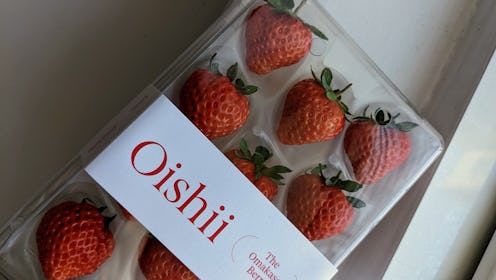Food
I Tried The $20 TikTok-Viral Oishii Strawberries — Here's What I Thought
Spending $20 on strawberries? In this economy?

The Greek philosopher Epicurus once said, “The root of every good is the pleasure of the stomach.” Though often misunderstood as a glutton, Epicurus believed spiritual fulfillment should be found in simplicity and, as one of life’s most basic needs, eating food should be enjoyable.
Working from home has changed how people eat lunch, and it’s no surprise that when you’re sitting in front of your computer, you’re more distracted by the task at hand than being present and taking notice of what you’re eating. I’m as guilty as the next person of this habit of distracted eating during the workday, but a seemingly simple experience with fruit had me reassessing this everyday practice — and appeasing Epicurus in the process.
What Are Oishii Strawberries?
It started a few weeks ago when the Instagram algorithm served me an advertisement for impossibly perfect strawberries. They were the most iridescent shade of red, I was convinced some kind of digital manipulation had occurred. The fruit is the brainchild of Hiroki Koga, who previously worked on indoor farming technology consulting before founding Oishii (pronounced “oy-she,” which is Japanese for “delicious”) in 2017. The berries, however, only recently amassed a cult following on TikTok, where the hashtag #oishiistrawberry has 6.2 million views and counting, thanks to their expansion beyond fine dining restaurants — they’re now sold direct-to-consumer in New York City, New Jersey, and California, as well as at certain Whole Foods and independent grocers in those areas.
Koga’s agricultural philosophy flies in the face of modern farming practices to which the United States is accustomed. Oishii places an emphasis on quality over quantity and focuses on hyperlocal farming, meaning the fruit doesn’t have to travel far to its final destination. (Lots of fresh produce in supermarkets is actually harvested before it gets ripe so that it can travel without spoiling, and is often artificially ripened once it reaches its destination. Flavor can suffer considerably as a result.)
An Oishii berry’s life begins at Mugen Farm (meaning “infinite” in Japanese) in New Jersey — the company has four indoor farms just off the New Jersey Turnpike. At 74,000 square feet, Mugen Farm is the world’s largest vertical strawberry farm (the berries are harvested in vertical stacks rather than traditional horizontal rows) and is designed to simulate the humidity, CO2 levels, and wind speed found at the foothills of the Japanese Alps. Tended to by a small crew of workers in hazmat suits, robots that collect data on each crop, and Oishii’s resident pollinating bees, the berries are cultivated 100% organically. You may also find they’re described as “Omakase” berries, taken from the traditional Japanese dining philosophy which translates to, “I leave it up to you.” Much like a diner putting trust in a chef to serve them something delicious, Oishii tells customers to “leave it up to us to serve you a perfect berry, every time, all year round.”
Of course, this all comes at a price, hence why TikTok star Tinx declared Oishii “rich mom strawberries” back in January — 11 medium-size berries, eight large, or six jumbo will set you back $20. If a small sample will suffice, it’s $6 for three. Indeed, when the machine at Whole Foods asked me, “Is this correct?” after swiping my credit card for $20 worth of strawberries, I admit it felt like a loaded question, but as the brand says on its website: “In Japan, fresh, clean, delicious fruit means there is a special occasion to celebrate” — and this was certainly a treat.
My Experience
I put aside half an hour and, per Oishii’s How to Enjoy The Omakase Berry guide (yes, there’s a guide), followed their instructions. I let the fruit come to room temperature and allowed the aromatics to “fill the room” for 10 to 15 minutes. When it was ready to eat, I did “enjoy the full breadth of the berry’s bouquet” before closing my eyes and taking a small, deliberate, almost sensuous bite.
Put simply, this is how a strawberry is supposed to taste — you know, the flavor that strawberry candy tries and usually fails to replicate. The berries were overwhelmingly sweet and juicy, with just the smallest hint of acidity. Over the next little while, I savored every bite. Then, I had a small but significant epiphany about finding pleasure in life’s simple things. A meal can be considered self-care, of course: Food provides the vitamins, minerals, and energy our body needs to stay alive and, in the case of strawberries, an excellent source of vitamin C. But why shouldn’t the experience be spiritual as well, as Epicurus suggested?
The Verdict
Oishii strawberries are beautiful. Are they tasty? Exceptionally. Practical? Certainly not on my budget, although apparently some customers buy multiple trays a week (must be nice). But if this Instagram-worthy fruit can serve as a reminder to slow down occasionally, to linger over our food, and to find pleasure even in a simple slice of toast in the morning, it is, at least philosophically speaking, worth every cent.
This article was originally published on